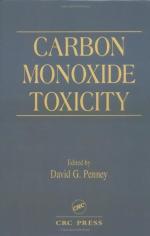|
This section contains 410 words (approx. 2 pages at 300 words per page) |

|
Carbon monoxide is an invisible, odorless, and poisonous gas with the chemical formula CO. Because of its toxicity, the U.S. Environmental Protection Agency (EPA) regulates CO. The gas is a by-product of incomplete combustion (burning with insufficient oxygen). Its major source is vehicle exhaust (60 percent). Other sources include water heaters and furnaces, gas-powered engines (boats and lawn mowers), charcoal and wood fires, agricultural burning, and tobacco smoke.
 Sources of Carbon Monoxide in the Home
Sources of Carbon Monoxide in the Home
CO is classified as an indirect greenhouse gas. It does not contribute to global warming directly, but leads to the formation of ozone. Ozone is the major air pollutant formed in photochemical smog and a potent greenhouse gas.
Human exposure to elevated CO impairs oxygen uptake in the bloodstream. Under CO-free conditions, oxygen is transported from the lungs to tissues by hemoglobin. When CO is present, it mimics the shape of...
|
This section contains 410 words (approx. 2 pages at 300 words per page) |

|


